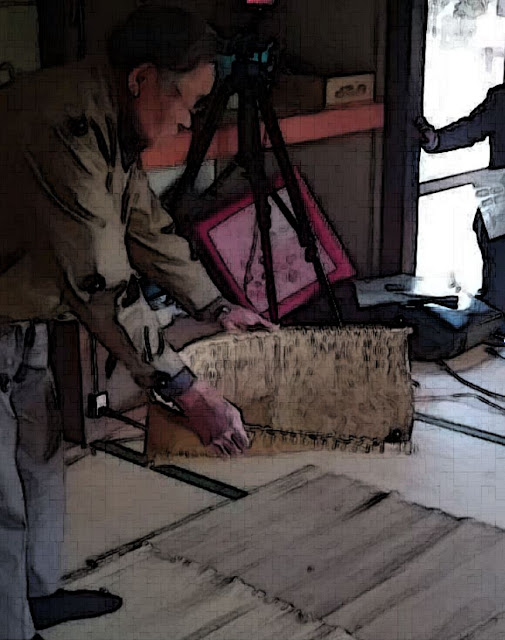包装紙として使用されている長方形状(横39㎝、幅17㎝)の越前和紙と薄手の画用紙を張り合わせて,正方形状(横25㎝、縦26.5㎝)にし,最もシンプルな紙箕を作ってみました。なぜこの越前和紙を使ったかというと,その紙の強さです。しぼり加工されたような表面の質感が興味深く,箕のイタミとしては弾性に欠けるような気もしますが,この風合いを箕型に適用したときの仕上がりが気になりましたので,手元にあった薄手の画用紙と合わせてみました。イタミの型としては,原図を必要としない正方形状のイタミを使うことにしました。
I made the simplest paper winnowing basket by pasting rectangular Echizen washi (39 centimeters long and 17 centimeters wide), used as wrapping paper, with thin drawing paper into a square (25 centimeters wide and 26.5 centimeters long). The reason why I used this Echizen washi was that it was particularly strong. I took an interest in its surface texture that felt as if it had been raised. It seemed to me that this Echizen washi was lacking in elasticity for itami, a board-shaped structure made by weaving thin bamboo sticks made of the torn outer skin of thin straight bamboo and skinned Japanese wisteria. But I wanted to see so much what finish the application of its texture to the pattern of winnowing basket would bring that I pasted it with a sheet of thin drawing paper at hand. For the pattern of itami, I decided to use square itami that needed no original drawing.
表
ここでは,この和紙の強さを生かすことを最優先としましたので,柄合わせは次の課題としました。和紙のもともとの寸法から最も無駄の少ないほぼ正方形状に和紙を配置し,同じ大きさの画用紙に,いつものヤマト糊で接着しました。十分に乾いた後は,紙箕初号機と全く同じです。まずは,このイタミを裏返し,イタミ型を描き込み
In this context, I gave priority to highlighting the strength of this washi, so pattern coordination was the second issue. Considering the original size of the washi, I arranged it in a near-square shape most efficiently and pasted it with drawing paper the same size by Yamato glue, which I usually used. I went through exactly the same process as the first model of paper winnowing basket after the washi dried completely. First, I turned the itami over, drew itami patterns as shown in the picture below,
裏
に従って
イタミに切り出し後
まで来ました。
cut off the outside part of akudo, the stand-up part on the exact opposite side of the opening at the front of a winnowing basket, and got this.
ここまで来ると柄合わせをしなかったことが悔やまれますが,まずはここでの一番の目的を目指します。
Now it is regrettable that I did not do pattern coordination, but the first thing I should do now is fulfill my primary purpose.
まずは,アクドを立て,サイドと重ね,
のようにアクドを立てて,全体の形を整えるととなり,これに幅5mm,厚み2mmの板状の竹ヒゴをウデキとして沿わせるととなりました。和紙のこわごわした感触と今回使用した画用紙のハリの弱さの割には,イタミとウデキとの弾性力による力の拮抗(バランス)は再現されているように見えます。少なくとも,制作直後はそうでした。時間が経ち,さらにイタミが乾燥してくると,この弾性によるバランス以上に和紙イタミの強さが支配的になり,やや使い込んだ箕の形態を呈し始めているようにも見えています。I erected akudo and tucked it together with the sides. I erected akudo like this, adjusted the entire form and got this picture. Then, I applied a plate-like thin bamboo stick 5 millimeters wide and 2 millimeters thick to this as udeki, a U-shaped frame tying a board-shaped structure made by weaving thin bamboo sticks made of the torn outer skin of thin straight bamboo and skinned Japanese wisteria, and got this picture. Despite the rough touch on washi and the weak firmness of the drawing paper, it seems that the balance of force by the elasticity of itami and udeki was recreated, at least shortly after the imitation was produced. As time goes by and itami further dries, the strength of the itami of washi became more predominant than the balance by the elasticity, which makes the imitation look like it is taking on the shape of a slightly used winnowing basket. 最後に,中央の福猫がとっても幸せそうです。 Anyway, the cat of good luck in the center looks very happy.









コメント
コメントを投稿